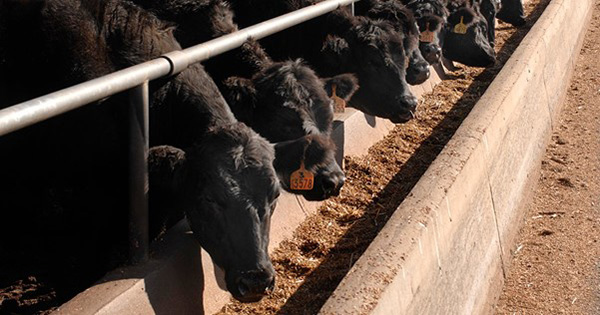Minimising the impact of bovine respiratory disease (BRD) in Australian feedlots
19 May 2022

Key points:
- A series of projects conducted by MLA and partners are looking at preventative measures for minimising the impact of bovine respiratory disease (BRD).
- An upcoming trial into autogenous vaccines will investigate potential vaccines for some of the bacterial pathogens involved in BRD.
- Emerging diagnostic technologies and an updated handbook for industry provide tools to prevent and manage BRD in beef feedlots across Australia.
Meat & Livestock Australia (MLA), within its feedlot program has a large R&D focus on preventative, diagnostic and extension measures for minimising the impact of BRD.
These measures include:
- development of new vaccines
- improving diagnostic technologies
- updating the Bovine Respiratory Disease Preventative Practices handbook for industry.
Dr Matt Van der Saag, MLA Project Manager – Feedlot & Sustainability said, “The aim of these projects is to improve and maximise the health, welfare and productivity of grainfed cattle, which in turn will increase enterprise profitability.”
Here are the most up-to-date reports of these projects so far.
Autogenous vaccine evaluation
Autogenous vaccines are custom vaccines produced from bacteria isolated from animals at the source feedlot to stimulate immunity against those strains included in the vaccine.
Commercial vaccines currently available in Australia offer protection against Bovine herpesvirus, Bovine pestivirus and Mannheimia haemolytica, whereas the BRD complex involves additional bacterial pathogens (e.g. Pasteurella multocida, Histophilus somni, Mycoplasma bovis, Trueperella pyogenes) that are not targeted by readily available vaccines.
MLA has joined forces with the University of Adelaide’s Associate Professor Kiro Petrovski and Apiam Animal Health’s Dr Tony Batterham, to evaluate if autogenous vaccines approved by the Australian Pesticides and Veterinary Medicines Authority (APVMA) confer additional protection from BRD, leading to:
- improved health and welfare
- reduced antimicrobial treatments
- increased profitability.
“This project, which will commence this year and conclude in December 2024, will deliver three large scale randomised block-controlled studies investigating one or two shot autogenous vaccine protocol for combined P. multocida and H. somni and a M. bovis autogenous vaccine,” Kiro said.
“We are currently working with MLA and Apiam Animal Health to determine which sites this trial will commence, as well as identifying the vaccine strain candidates. This will be followed by regular surveillance and testing of those specimens thereafter for the duration of the project,” he said.
Based out of Quirindi in north-west NSW, Tony noted that the upcoming study promises exciting news for beef feedlot operators and possibly other beef producers who can utilise the technology.
“This project seeks to provide an additional preventative control measure for BRD in beef feedlots, utilising autogenous vaccines approved by the APVMA,” Tony said.
“In this way, livestock teams working in beef feedlots could readily access these additional tools to mitigate BRD’s impact to the Australian beef sector.
“The vaccines are tailor-made to each feedlot site who are providing source material. However, they require ongoing surveillance of the bacterial pathogens operating.
“This does align with good antimicrobial stewardship practices, delivering a win-win to operators and customers.
“These are positive developments for the beef industry.”
Emerging diagnostic technologies
Alongside vaccines, diagnostic technologies are an essential way to minimise and prevent BRD in feedlot cattle.
An ongoing project between MLA and Charles Sturt University (Charles Sturt) through the Gulbali Institute of Agriculture, Water and Environment, in collaboration with NSW Department of Primary Industries (NSW DPI) is looking to quantify the cost of disease in feedlots including losses associated with carcases condemned with BRD.
Charles Sturt Professor Jane Quinn said, “The project uses quantitative real-time polymerase chain reaction (qPCR)-based diagnostic methods to identify a range of pathogens related to BRD, within the same day, allowing this to be used for whole mob decision making.
“Through our tests so far, we have found that these diagnostic tests show a quantitative concentration of potential pathogens in an animal.
“The reason this is important, is because this can show which animals are at risk of BRD before they get it.”
The technology development, led by Dr Ian Marsh at the Elizabeth Macarthur Agricultural Institute (EMAI, NSW DPI), is now in the final stages of testing. The project is now undertaking an economic analysis and intervention modelling to understand how the tests can be practically incorporated into a commercial feedlot.
Bovine Respiratory Disease Preventative Practices handbook – 2021
MLA is also committed to providing easily accessible information for Australian beef feedlot organisations and processors around BRD.
In 2016, MLA published the Evaluation of practices used to reduce the incidence of bovine respiratory disease in Australian feedlots. In 2021, MLA worked with Dr Paul Cusack at Australian Livestock Production Services (ALPS) to develop an updated handbook for the industry.
The updated handbook will contain new information relating to environmental, animal and management factors that affect the incidence of BRD in lot fed cattle published between 2016–2021.
“It provides a single source for lot feeders and their consultant veterinarians to access the latest information on BRD and how to prevent it,” Paul said.
“Since the initial document was written, various new developments in peer reviewed literature and industry best practice have emerged. We wanted to make sure that these important developments were captured in the updated version.
“Although the information is deeply technical, it can really prove to be the world of difference to you, your cattle and your business.
“We’re very excited to see the new updated handbook available on the MLA website.”


